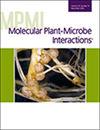Qi Wang, Kira M Veley, Joshua M B Johnson, Josh Sumner, Gijs van Erven, Mirjam A Kabel, Singha Dhungana, Jeffrey Berry, Adam Boyher, David M Braun, Wilfred Vermerris, Rebecca S Bart
求助PDF
{"title":"Three <i>Xanthomonas</i> Cell Wall Degrading Enzymes and Sorghum <i>Brown midrib12</i> Contribute to Virulence and Resistance in the Bacterial Leaf Streak Pathosystem.","authors":"Qi Wang, Kira M Veley, Joshua M B Johnson, Josh Sumner, Gijs van Erven, Mirjam A Kabel, Singha Dhungana, Jeffrey Berry, Adam Boyher, David M Braun, Wilfred Vermerris, Rebecca S Bart","doi":"10.1094/MPMI-05-24-0051-R","DOIUrl":null,"url":null,"abstract":"<p><p>With an increasing demand for renewable fuels, bioenergy crops are being developed with high sugar content and altered cell walls to improve processing efficiency. These traits may have unintended consequences for plant disease resistance. <i>Xanthomonas vasicola</i> pv. <i>holcicola</i> (<i>Xvh</i>), the causal agent of sorghum bacterial leaf streak, is a widespread bacterial pathogen. Here, we show that <i>Xvh</i> expresses several bacterial cell wall degrading enzymes (CWDEs) during sorghum infection, and these are required for full virulence. In tolerant sorghum, <i>Xvh</i> infection results in the induction of a key enzyme in monolignol biosynthesis, <i>Brown midrib12</i> (<i>Bmr12</i>), but this did not affect lignin content nor composition. Mutation of <i>Bmr12</i> rendered the tolerant genotype susceptible. <i>Bmr12</i> encodes caffeic acid <i>O</i>-methyltransferase (COMT), an enzyme that generates sinapaldehyde as its major product. Growth inhibition of <i>Xvh</i> in the presence of sinapaldehyde was observed in vitro. We conclude that mutations that alter the components of the sorghum cell wall can reduce sorghum resistance to <i>Xvh</i> and that <i>Xvh</i> CWDEs contribute to bacterial virulence. Given the enhanced bioprocessing characteristics of <i>bmr12</i> sorghum, these results provide a cautionary tale for current and future efforts aimed at developing dedicated bioenergy crops. [Formula: see text] Copyright © 2025 The Author(s). This is an open access article distributed under the CC BY 4.0 International license.</p>","PeriodicalId":19009,"journal":{"name":"Molecular Plant-microbe Interactions","volume":" ","pages":"400-410"},"PeriodicalIF":3.4000,"publicationDate":"2025-05-01","publicationTypes":"Journal Article","fieldsOfStudy":null,"isOpenAccess":false,"openAccessPdf":"","citationCount":"0","resultStr":null,"platform":"Semanticscholar","paperid":null,"PeriodicalName":"Molecular Plant-microbe Interactions","FirstCategoryId":"99","ListUrlMain":"https://doi.org/10.1094/MPMI-05-24-0051-R","RegionNum":3,"RegionCategory":"生物学","ArticlePicture":[],"TitleCN":null,"AbstractTextCN":null,"PMCID":null,"EPubDate":"2025/3/13 0:00:00","PubModel":"Epub","JCR":"Q2","JCRName":"BIOCHEMISTRY & MOLECULAR BIOLOGY","Score":null,"Total":0}
引用次数: 0
引用
批量引用
Abstract
With an increasing demand for renewable fuels, bioenergy crops are being developed with high sugar content and altered cell walls to improve processing efficiency. These traits may have unintended consequences for plant disease resistance. Xanthomonas vasicola pv. holcicola (Xvh ), the causal agent of sorghum bacterial leaf streak, is a widespread bacterial pathogen. Here, we show that Xvh expresses several bacterial cell wall degrading enzymes (CWDEs) during sorghum infection, and these are required for full virulence. In tolerant sorghum, Xvh infection results in the induction of a key enzyme in monolignol biosynthesis, Brown midrib12 (Bmr12 ), but this did not affect lignin content nor composition. Mutation of Bmr12 rendered the tolerant genotype susceptible. Bmr12 encodes caffeic acid O -methyltransferase (COMT), an enzyme that generates sinapaldehyde as its major product. Growth inhibition of Xvh in the presence of sinapaldehyde was observed in vitro. We conclude that mutations that alter the components of the sorghum cell wall can reduce sorghum resistance to Xvh and that Xvh CWDEs contribute to bacterial virulence. Given the enhanced bioprocessing characteristics of bmr12 sorghum, these results provide a cautionary tale for current and future efforts aimed at developing dedicated bioenergy crops. [Formula: see text] Copyright © 2025 The Author(s). This is an open access article distributed under the CC BY 4.0 International license.
三种黄单胞菌细胞壁降解酶和高粱褐中脉12对细菌条纹病毒力和抗性的影响
随着对可再生燃料的需求不断增加,人们正在开发高糖含量和改变细胞壁的生物能源作物,以提高加工效率。这些性状可能对植物抗病性产生意想不到的影响。血管黄单胞菌。holcicola (Xvh)是一种广泛传播的致病菌,是高粱细菌性条纹病的致病因子。在这里,我们发现Xvh在高粱感染期间表达了几种细菌细胞壁降解酶(CWDEs),这些酶是完全毒力所必需的。在耐受性较强的高粱中,xh感染诱导了单木质素生物合成的关键酶Brown midrib 12 (Bmr12),但这并不影响木质素的含量和组成。Bmr12突变使耐药基因型易感。Bmr12编码咖啡酸o -甲基转移酶(COMT),这是一种产生新加坡醛的酶。体外观察了sinap醛对xh生长的抑制作用。我们得出结论,改变高粱细胞壁成分的突变可以降低高粱对Xvh的抗性,并且Xvh CWDEs有助于细菌毒力。鉴于bmr12高粱增强的生物加工特性,这些结果为当前和未来旨在开发专用生物能源作物的努力提供了警示。
本文章由计算机程序翻译,如有差异,请以英文原文为准。

 求助内容:
求助内容: 应助结果提醒方式:
应助结果提醒方式:


